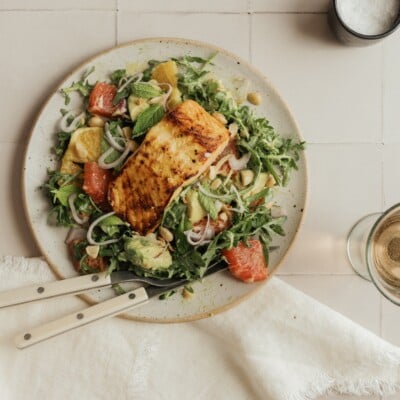While plant-based eating has become popular culture now, being raised a vegetarian during the 80s was challenging. Don’t get me wrong, I’ve always loved being a vegetarian, but I was definitely an outcast at school. My mom was a total hippie too made nut meat before it was cool and poured us goat’s milk to avoid the lactose. And my dad had long hair with a mustache and drove a vintage blue Volkswagon Kombi. You can imagine how my school drop-off went down, haha. To this day, I still haven’t eaten meat (I’ve tried fish, prawns, and chicken but no red meat) and despite the teasing and numerous questions at school (I can’t tell you how many times I’ve been asked “where do you get your protein?”), now I am grateful to my parents for raising me on a plant-based diet. There are so many health benefits of a plant-based diet, and we tapped an expert for all there is to know.
Research shows that a plant-based diet is associated with a lower risk of heart disease. The most studied diets are the Mediterranean diet, the DASH diet, and the MIND diet which are all rich in fiber, vitamins, and minerals that help lower blood pressure and LDL (bad) cholesterol, reduce the risk of diabetes and help to maintain a healthy weight, which all in turn help reduce your risk of heart disease. And then there are the environmental benefits—UN experts say switching to a plant-based diet can help fight climate change.
Fellow plant-based outlier, Kimberly Snyder was really at the forefront of this trend. The holistic nutritionist helped to spearhead this green lifestyle movement when she moved from New York to Los Angeles in the early 2000s touting the benefits of her iconic Glowing Green Smoothie (more on that later!). Her passion for nutrition and plant-based living quickly drew the attention of major celebrities like Drew Barrymore (she’s still a fan!), Channing Tatum, Kerry Washington, and more—and it’s easy to see why. Synder is a vision of health and wellness. But it’s not just aesthetics, she has a vibrant energy that we all want to tap into.
After the success of her first book, The Beauty Detox Solution, Snyder has built a community (and budding empire) around her plant-based philosophy which now includes a Melrose Avenue juice bar, a supplements line called Solluna that includes “soil-grown” probiotics, and two more New York Times best-sellers, The Beauty Detox Power, and The Beauty Detox Foods.
“When I started to transform my lifestyle, I always felt instinctively drawn to being plant-based,” Snyder tells me. “I started to think of things in terms of energy and that go beyond numbers such as the ways that we digest, metabolize and detox. I also learned about being vegan when I started studying yoga and meditation and being plant-based because it supports meditation and lightness. Then I started understanding how things are so interconnected, and the environmental consequences that come from eating meat. It became very clear to me for many different reasons!”
Snyder further outlined that our bodies are designed to eat a diet primarily made up of plant foods: greens, fruits and vegetables, sprouts, seeds, and nuts. “With this type of diet, we flourish and derive all our necessary nutrients, while also keeping our bodies toxin-free and looking our most beautiful,” she adds. With more and more people interested in longevity, decreasing the risk of disease, the gut-brain microbiome, and saving the environment, Snyder predicts the plant-based way of life will only continue to gain momentum. “The more people awake, the more plant-based will continue to rise!” she says. Below, Snyder dives deeper into the health benefits of a plant-based diet, how to get started, and what to avoid. And don’t forget to scroll to the end for her Glowing Green Smoothie recipe.
And if you haven’t signed up already, today is the official launch of part of our Plant-Based RE:SET—a new 5-day meal plan with original recipes to help you eat more plants! Packed with delicious breakfast, lunch, and dinner recipes, this is a week’s worth of meals that’ll leave you feeling lighter, brighter, and energized. Sign up here!

Is a plant-based diet healthier?
Yes, three reasons below:
# 1. Better digestion & cleansing.
A plant-based diet has so many amazing benefits for your body overall, but better digestion and cleansing are such a fundamental part of it. When you overload on animal protein, like meat and dairy, the digestion of these proteins produces toxins in the body and slows down the system. This often causes gas, bloating, constipation, and increased toxicity, which leads to lots of health issues down the road!
When you switch to a plant-based diet, by default, you start to eat more vegetables, fruits, whole grains, nuts, and seeds to fill in the gaps in your diet where animal products were. Plant foods have the most nutrients and fiber in them per volume. The side effect of eating a plant-based diet is getting many more micronutrients and a lot more fiber, which helps optimize digestion and ongoing cleansing. As a result, digestion improves and your body is less toxic overall.
#2. Weight loss & increased energy.
A plant-based diet also has such powerful weight loss and energy-boosting benefits when done correctly. In general, weight loss is a typical side effect of eating a diet rich in whole, plant-based foods because you hold onto less acidic and toxic waste, which is stored in fat cells. Plus, when you free up energy from digestion, it can go into cleansing and detoxification and aid weight loss.
In addition, filling up on fiber-rich plant foods means you usually get full after eating fewer calories. Fiber regulates blood sugar and creates a feeling of fullness and a sustained release of nutrients into your system so you don’t burn out or crash. The result is feeling lighter and more energetic all around.
#3. Beauty & anti-aging benefits.
As I always say, outer beauty is a reflection of inner health. The side effect of eating more plant foods and less toxic animal products is that true beauty stems from the inside out. Going back to the root of digestion and cleansing, when your system isn’t overloaded with toxins and heavy waste, it has more energy to strengthen and repair cells from within. The result is brighter eyes, stronger nails, glowing skin, shiny hair, and reduced wrinkles.
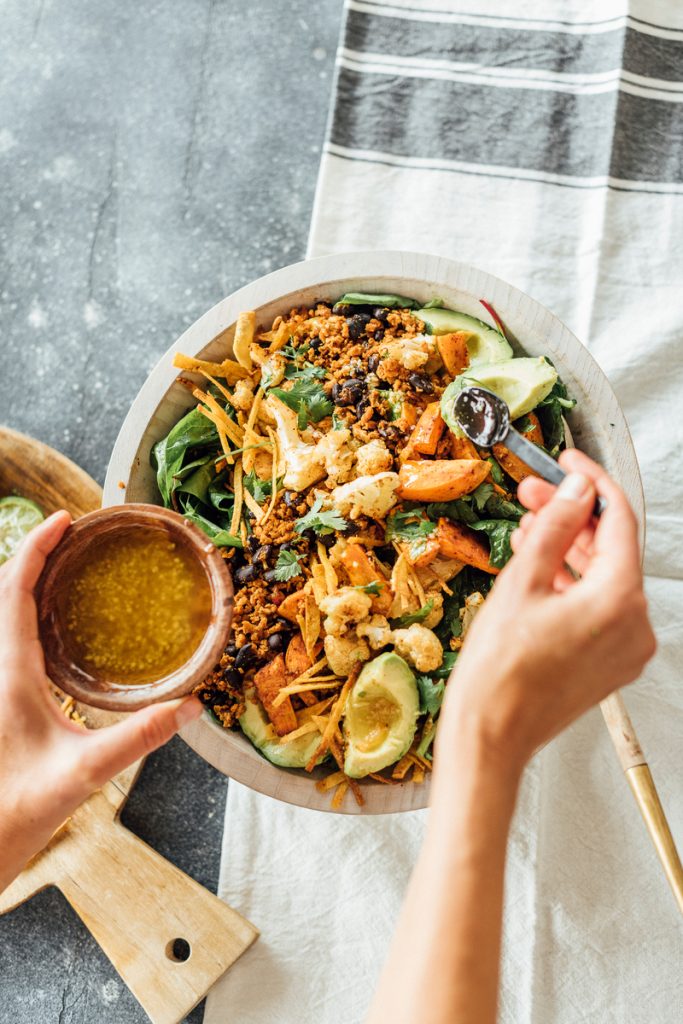
How is going plant-based different from being vegetarian or vegan?
Going plant-based is predominantly focused on consuming more plants vs. the focus being on what you omit from your diet. All of these ways of eating are plant-forward, but they are quite diverse in that some people include small amounts of animal products. A vegan diet totally eliminates all animal products. In addition, vegans focus on protecting animals by avoiding all animal products. Plant-based is more inclusive for everyone. I don’t think it has to be all or nothing, especially when people are transitioning. I also personally often avoid the word “vegan”, because it can feel polarizing to some.
As a vegetarian since birth, I am constantly asked how I get my protein. Can you please share some of the ways you can get protein with a plant-based diet? Should you supplement with a powder? If so, which one do you recommend?
The protein question is one of the most commonly-asked questions I’ve gotten when it comes to making changes to diet.
Hemp, brown rice, pea, pumpkin seeds, coconut, and chia seeds are typical protein sources in vegan protein powders. Each of these ingredients provides the body with easily-digestible protein along with a range of additional nutritional benefits. You’ll often see vegan protein powder formulations with a combination of a few of these sources, offering a fuller range of amino acids and higher protein content.
I am personally a fan of protein formulas that include protein from organic hemp seeds, along with a variety of other plant-based sources. Hemp is a plant that has not been subjected to genetic modification. It is extraordinarily hearty, so it doesn’t require farmers to use pesticides, making it a wonderful, safe source of protein!
I’ve been having daily protein smoothies because it’s a great way to get protein count up in an efficient way, especially if you are pregnant, training, or simply looking for a healthy and filling snack option.
Protein bioavailability is an important factor in deciding what type of protein supplement to use, which is why I always recommend finding a quality vegan protein powder. With so many choices in a truly saturated market, it can be a bit confusing and all protein powders are not created equal. Proper ratios, supportive ingredients to maximize optimal absorption (such as enzymes and probiotics) and sourcing are just a few of the considerations. I always recommend looking for non-GMO, organic powders that list complete amino acid profiles on the label.
Protein powders I recommend are:
Vega: I personally know and trust the formulator, and I know a great deal of research and testing has gone into making a superior product that is non-GMO and boasts 30 grams of protein per scoop/serving.
Sunwarrior Organic Warrior Blend: Medium-chain triglycerides from coconut then join this dynamic fusion to create a unique plant-based protein amino acid profile, containing Arginine, Lysine, Leucine, and branched-chain amino acids.
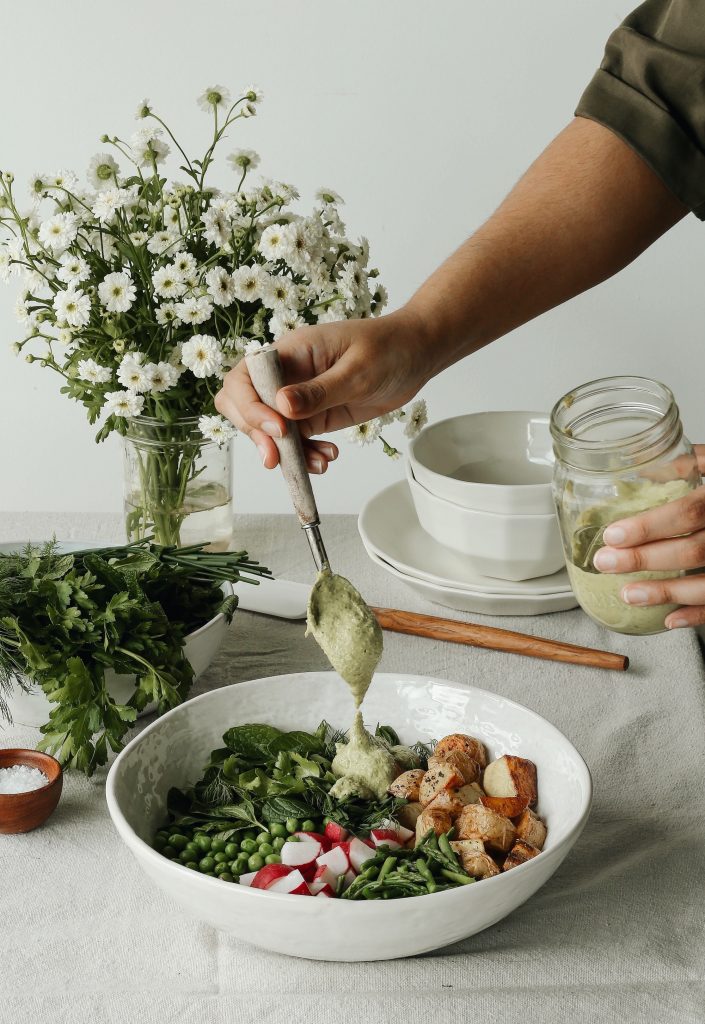
How do you make the switch to a plant-based diet?
Remember it’s all about progress and not perfection. No matter what we put into our bodies—organic vegetables, superfoods, the purest water—it’s the thoughts we think, the words we use, and the actions we take that help define who we are and that ultimately shape our lives.
It’s about an inner and outer transformation, which may not be instantaneous, yet it can happen relatively quickly when you incorporate the best nutrition and incorporate the Beauty Detox lifestyle with my Four Cornerstone philosophy which involves food, body, emotional wellbeing, and spiritual growth.
Start with choosing one or two tips around each cornerstone and slowly implement these into your daily life. Keep track by journaling each day and noticing how your body feels, listening to your body’s needs, and making adjustments where needed.

What does the plant-based plate look like?
When I’m cooking batches of food, whether it’s a meal or dessert, I always store it, pre-portioned, in separate containers. That way, when I reach for it next time, I’m not tempted to over-serve myself. I also recommend stocking your fridge full of raw veggies and salad. These foods are loaded with fiber, so they tend to fill you up before you can overeat. Additionally, it’s easy to mistake dehydration as a hunger cue, so make sure you’re staying hydrated with plenty of lemon water throughout the day, which will help curb your appetite.
I recommend stocking the kitchen with plenty of fresh produce for optimal health. I advise my clients to start every day with my Glowing Green Smoothie (see recipe below), which is loaded with fresh fruits and veggies. For a big time saver, I recommend making it in batches to freeze for later use, which is also a great way to use up extra produce before it goes bad. I always have fresh lemons on hand, which I squeeze into hot water every morning, add to my smoothies and throw on salads, for an immunity and detoxification boost!
I’m a big fan of having foods for gut health on hand in your kitchen at all times. These include raw sauerkraut, which is loaded with probiotics for supporting the gut, and fresh ginger root for digestion. To supplement gut health, I recommend taking an excellent probiotic supplement every day, like my SBO Probiotic.
Lastly, I encourage filling the pantry with dry staples like quinoa, lentils, vegan protein powder, organic spices, and chia seeds that you can always have on hand for quick meal options when you’re running low on groceries. You can save money by shopping the grains, legumes, seeds, and nuts in bulk online or at co-ops.
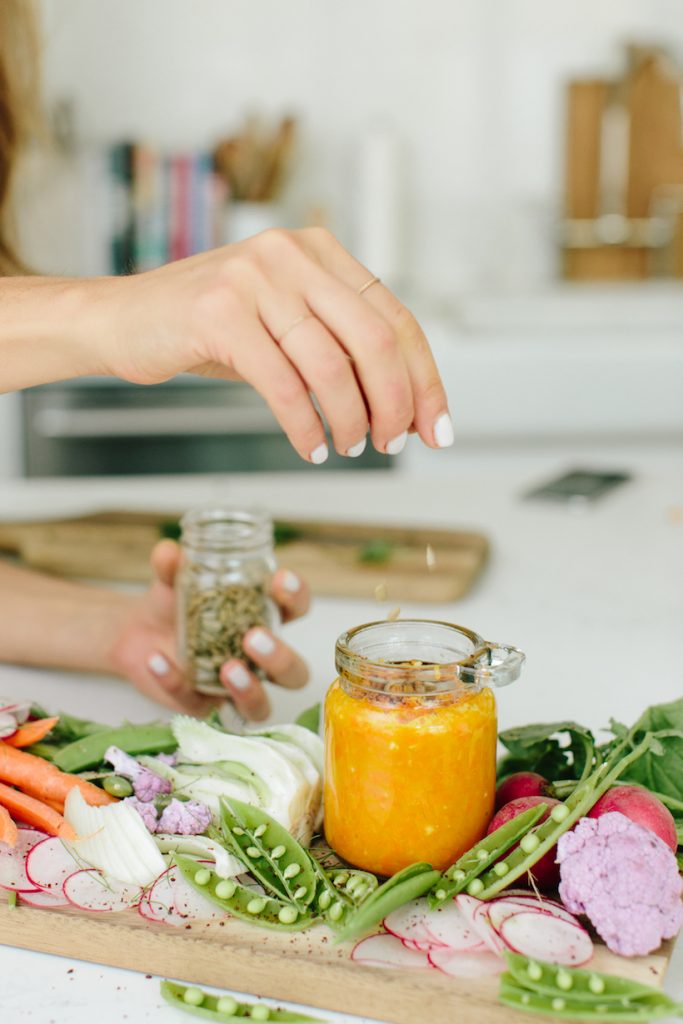
What are some foods to avoid on a plant-based diet?
Eliminate dairy.
What’s more, ditching the dairy could mean stronger bones. Crazy, right? As shocking as it may sound, recent research has begun to debunk the link between dairy products and bone health. In fact, in one study, researchers found that women not only gained no bone-strengthening benefit from drinking more milk but that drinking three or more glasses per day was associated with a significant increase in their risk of bone fracture.
Cut out meat.
When you cut meat out of your diet, you will make up for that food group with higher proportions of heart-healthy whole grains and nuts, as well as plenty of fruits and vegetables. As a result, you’ll likely be getting higher amounts of dietary fiber, vitamins, minerals, and antioxidants.
Eliminate refined sugar.
Refined and processed sugar can totally sabotage your weight, but it’s also been linked to a slew of serious health problems. In fact, a growing body of research on sugar has shown it can negatively impact your brain function, heart health, and overall mood.
Eliminate carbonated beverages and energy drinks.
Along with withdrawal symptoms, caffeine causes other physical issues including dehydration, jitteriness, and stomach problems. Caffeinated beverages may also exacerbate certain health conditions, including anemia, irritable bowel syndrome, kidney stones, osteoporosis, ulcers, premenstrual syndrome.
Avoid gluten grains.
Wheat and other gluten-containing crops are commonly sprayed with copious amounts of pesticides and herbicides. These harmful chemicals are still very much present in the foods that are made from them and enter your body upon consuming them, undermining your natural beauty, and potentially causing health problems over time. Exposure to pesticides/herbicides and their ingested residues has been linked to everything from headaches, dizziness, and fatigue to certain forms of cancer.
Wheat and other such gluten-containing crops are heavily sprayed with chemicals, they are also often stored in silos for long periods of time due to the staggeringly vast amounts that are farmed annually, so mold and fungus contamination are very valid concerns. And then there is the possibility of being sensitive to the actual gluten itself that affects so many people—some more, and in different ways, than others.
Probably the most well-known explanation for gluten sensitivity is celiac disease. It is an autoimmune disorder in which the lining of the small intestine is actually damaged by the consumption of gluten, causing symptoms of abdominal stress like excessive gas, bloating, diarrhea, and sometimes vomiting. Other symptoms include everything from migraine headaches and joint pain to fatigue, depression, and even seizures. Since there is no actual known cure, the very best (and currently the only way) way to address the problem is with a gluten-free diet.
Avoid processed foods.
Each fast food meal digests to leave hormones, steroids, next-to-impossible to digest oils, cheap refined sugars, and so many other horrible substances in your body.
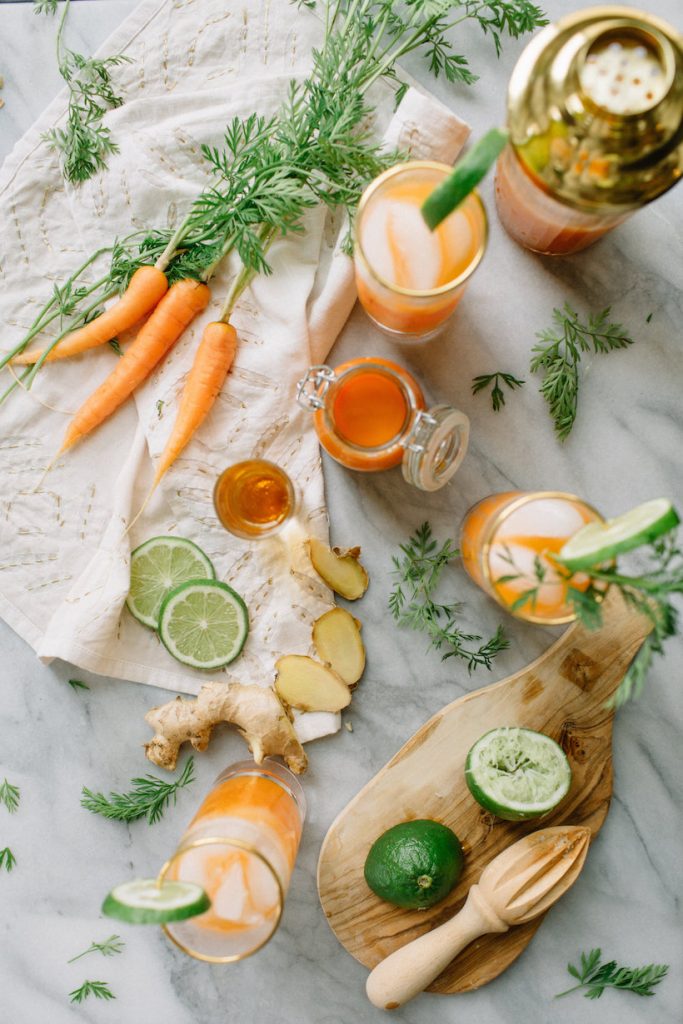
Is plant-based better for the environment?
I know many of you, like me, look for ways we can really honor the Earth. We want to contribute in some way to maintaining its beauty and life-sustaining gifts to us all.
Prior to 1970, there were no environmentally protective mechanisms put into place. We have made important strides over the years in creating better protections for us all, but there is so much more we can do. We all have a role to play and an opportunity to contribute. Our actions don’t need to be large or grandiose either. Sometimes it’s the small everyday choices we make that create the biggest impact.
One simple thing we can do is make a change to how we eat. Many people are unaware of how powerful addressing the climate crisis through our eating habits truly is. The climate crisis affects us all, and what we eat and how we eat should be a big part of the discussion.
There is a saying in Ayurvedic medicine that goes, “As is the micro, as is the macro.” When we begin to address our personal choices and lifestyle, it really does affect the greater whole, the greater community, nature, and the entire world.
Many of you are already living a life in alignment with my recommendations below and these ideals. For some of you, this is new or you’re just starting. Wherever you are in your journey today, just remember we’re here to support you!
Here are a few things you can do now to further reduce your carbon footprint:
Eat plant-based.
I believe the number one thing we can do to protect the environment is to eat plant-based. For those of you who aren’t yet ready to be 100% plant-based, I encourage you to try to eat a mostly plant-based diet.
There is a lot of information online now that supports plant-based diets, not just for the environment, but for your health and longevity too. What’s good for Mother Earth is good for us too!
I encourage you to do your own research and come to your own conclusions. There are many great documentaries available today to watch too. One I personally recommend is Cowspiracy. If you’ve already watched it, you’ll know why!
I also encourage you to read books written by the well-respected environmentalist and author Paul Hawken. He speaks all over the world and writes about important environmental solutions.
Many people choose to eat “healthier” meat by consuming organic or free-range poultry and beef, and these are healthier choices, but many don’t realize that even with free-range, large amounts of land are needed for the cattle to graze on.
With the growing population and increased demand for meat, more land is needed. This results in deforestation. About 90% of the destruction of the rainforest comes from cattle raising.
Our oceans are overfished, and the big trolling fishing nets kill other sea life like dolphins. The more we eat a plant-based diet, the less of a detrimental impact we have on the earth.
Buy local & organic.
How far your food travels matters. There are real environmental costs linked to our food choices. The food you buy in a grocery store that has traveled a long distance to get there may often look the same (although I’d argue they don’t taste the same), but they’re worlds apart environmentally.
Eating more local food helps reduce CO2 emissions by reducing the distance food has to travel from the farm to you.
Did you know the average piece of produce in the US travels 1500 miles?! Most local food travels fewer than 100 miles.
There is not only the impact that transporting the food has on the environment, but we’re also removed from the farming practices used. Many local farmers have a smaller footprint and use more sustainable farming practices when growing their food.
Local farmer’s markets are a great place to find high-quality food with less of an impact on our environment.
Grow your own food.
I’m also a big fan of growing your own food if possible. When you grow your own food you are 100% in control of what goes in the soil and on the food. You’re able to reduce the use of toxic chemicals on the food and what goes into the soil.
When chemicals get in the soil, it pollutes the environment and ground waterways. If you grow your own organic fruits and vegetables and use safe and natural fertilizers, you’re doing your part to keep our earth safe.
I also encourage you to use all parts of your food, including vegetables. I like to take my scraps and make my own stock. I also compost and add it to my garden to create healthier soil.
There are so many other small simple things we all can do that add up to something truly impactful. These are just a few. Today, think about how you can incorporate these three things into your life.
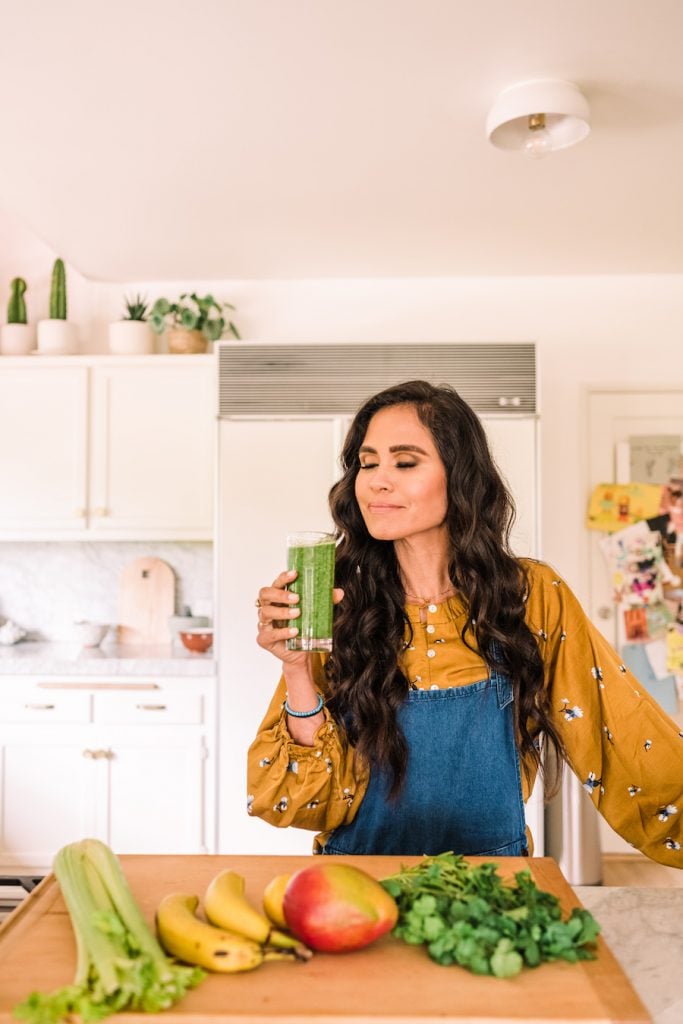
What are the health benefits of your Glowing Green Smoothie?
My iconic Glowing Green Smoothie® (GGS) is one of the most potent health and beauty elixirs, which is why I encourage everyone to start their morning off with the GGS. It’s so impactful because it contains a special ratio of ingredients, that combines mineral-rich greens, vitamin-packed fruit, and detoxifying lemon, in the most beneficial way for the best nutrition and overall radiance. I spent years perfecting the GGS, which is why it effectively builds skin health and radiance from the inside out.
The Glowing Green Smoothie is packed with specific vitamins, minerals, antioxidants, fiber, high-quality amino acids (that build protein important for healthy skin), and phytonutrients that work synergistically to prevent and repair damage in the body and boost rejuvenation. Celery, which is a core ingredient of the smoothie, is great for balancing our electrolytes and helping to depuff the skin. Lemon is another staple ingredient of the GGS, which nourishes the body with vitamin C and enzymes. Lemons are effective in boosting liver function and tissue regeneration, and the result is clearer skin and more energy. Bananas also provide a lot of organic potassium, which helps to balance the fluid in our body and keep skin hydrated. Any time we’re giving our skin these foods which are really balanced within themselves, it’s going to really help balance our skin as well.
The GGS works to nourish your cells and cleanses the body from the inside out, freeing it from the toxic waste that contributes to a number of issues like acne and brittle nails. A smoothie full of beautifying ingredients works synergistically to prevent and repair damage and boost rejuvenation. The result? Glowing, supple skin, shiny hair, strong nails, and increased energy!
The Glowing Green Smoothie Recipe
Ingredients:
7 cups chopped spinach (about a medium bunch)
6 cups chopped romaine lettuce (about 1 small head)
2 cups cold filtered water
1 1/2 cups chopped celery (about 2 medium stalks)
1 medium apple, cored and coarsely chopped
1 medium pear, cored and coarsely chopped
1 medium banana, peeled and cut in thirds
2 tablespoons freshly squeezed lemon juice
1/2 cup minced fresh cilantro (stems are okay)(optional)
1/2 cup minced fresh parsley (stems are okay)(optional)
Directions:
Place all of the ingredients into a blender and blend until smooth. Pour into a cup and enjoy!
Want more delicious recipes like this? Join us for our Plant-Based RE:SET—a new 5-day meal plan packed with delicious breakfast, lunch, and dinner recipes that’ll leave you feeling lighter, brighter, and energized. Sign up here!




